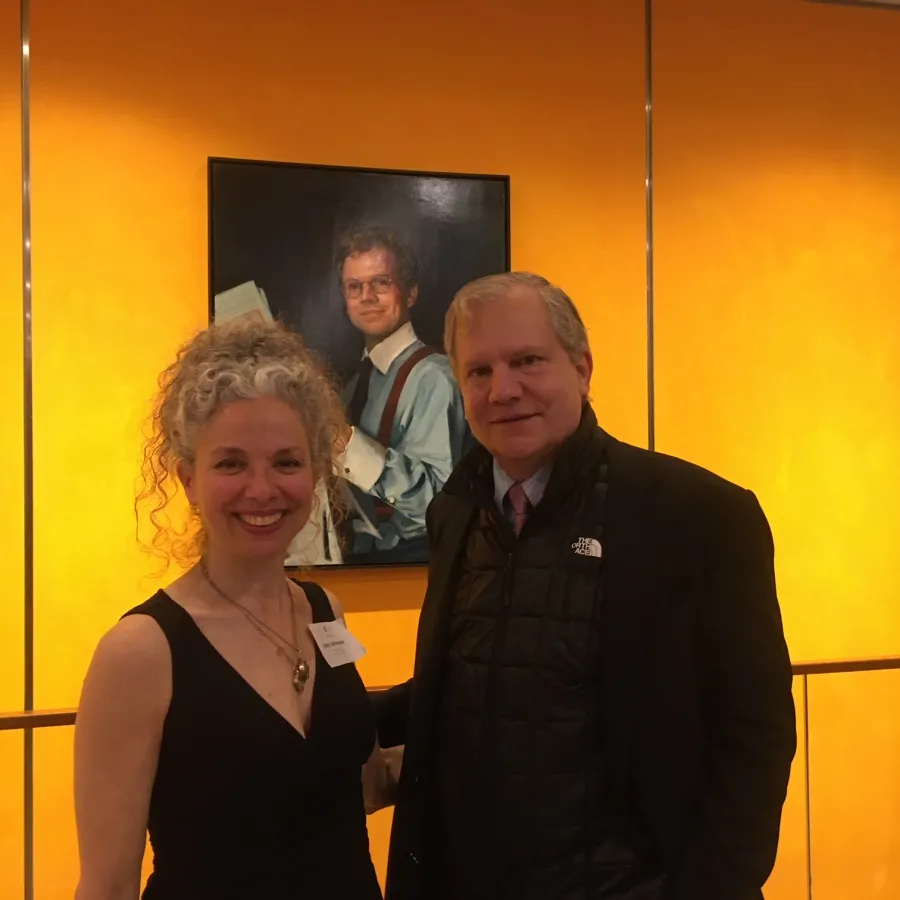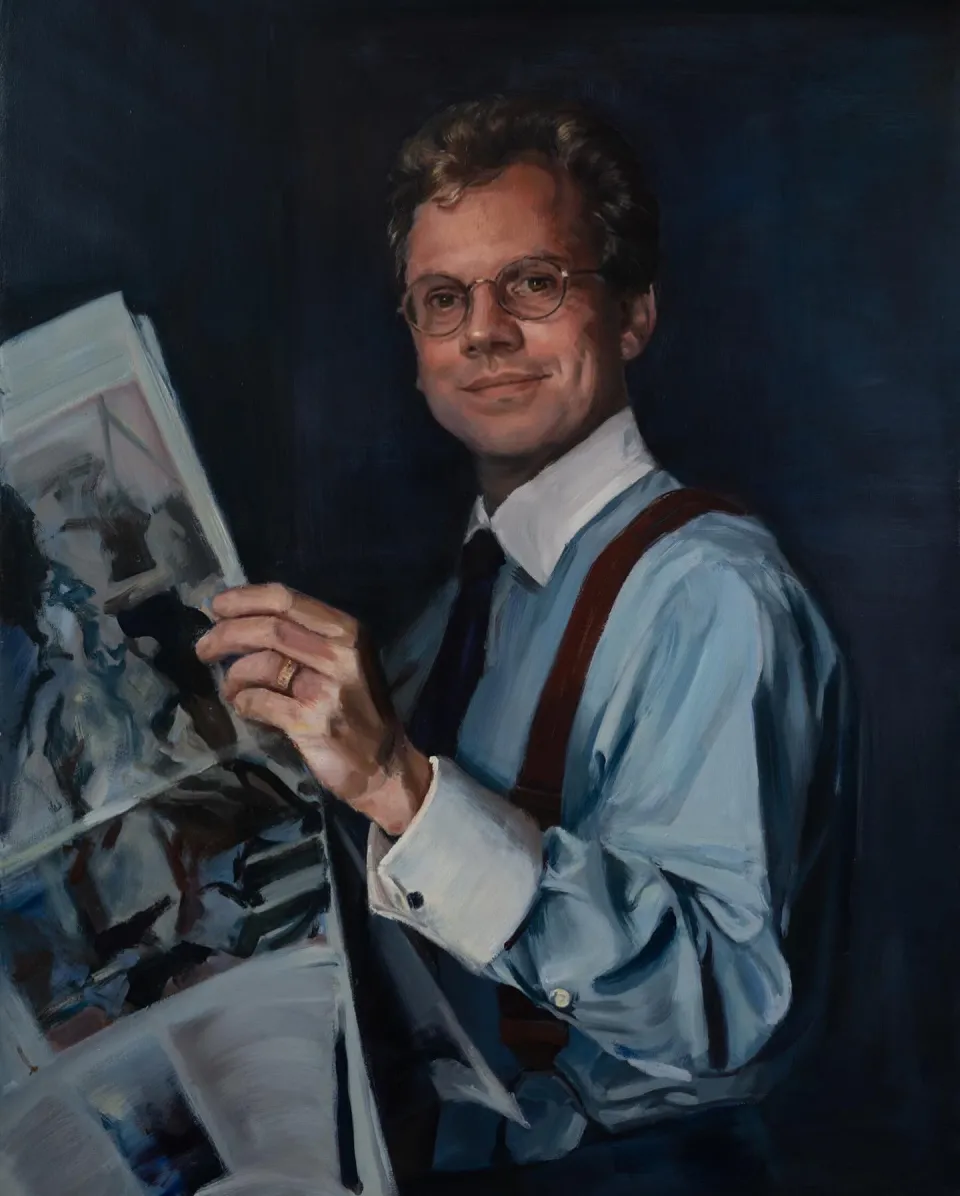Adventures in Portraiture
Faculty
Faculty member Katy Schneider paints a newspaper icon
Katy Schneider poses with Arthur Ochs Sulzberger, Jr. in front of the recently unveiled painting of the former New York Times publisher. Photo by Alice Schneider.
Published April 12, 2024
Artist and longtime Smith faculty member Katy Schneider is no stranger to the art of portraiture.
Her painting of former Smith President Carol Christ now hangs in the Klingenstein Browsing Room in Neilson Library. Another of her self-portraits is currently on view at the Smith College Museum of Art.
A recent commission, however, posed an unusual artistic challenge. Schneider, a lecturer in art, was selected last spring to paint a portrait of Arthur Ochs Sulzberger, Jr.—a former publisher of The New York Times and a member of the family that is central to the newspaper’s 173-year-old history.
The work would be done without Sulzberger sitting for the artist. “I had one photo and a paragraph about him to work from,” Schneider says “I had to call upon my every skill.” Raoul Anchondo, a staff editor at the Times who manages the paper’s art collection, had seen Schneider’s still life paintings at a gallery exhibit in Hudson, New York, and asked her to be considered for the Sulzberger commission.
“Katy stood out as a favorite of everyone’s,” Anchondo says. “She thinks about art and portraiture in a deep way. We felt she would provide some consistency with the style of our other portraits, while infusing this one with new vibrancy and energy.”
Schneider’s painting—a result of more than 200 hours of work—was unveiled April 4 on the 15th floor of the Times building in Manhattan, where it will be displayed along with portraits of the paper’s other publishers in an area near a new museum exhibit.
Sulzberger’s son, A.G. Sulzberger—the current publisher of The New York Times—says the portrait captures his father’s “willingness to push change, take risks, and make tough decisions,” including a decision to put color on the front page in 1997.
“Arthur understood intuitively that stewardship did not mean standing still, that continuity requires change,” A.G. Sulzberger said. “That wisdom is a big part of why the Times is thriving today.”
For her part, Schneider says the unveiling event was “really fun. Everyone was warm and appreciative. I was happy to hear from friends and relatives who had known Arthur” at the age he appears in her portrait.
Katy Schneider’s portrait of Arthur Ochs Sulzberger, Jr., former publisher of the New York Times.
Photo by Andrew Held
Here’s what else she had to say about her commission for the newspaper.
How did you prepare for painting the portrait of Arthur Sulzberger Jr.?
“Typically, I prefer to paint from direct observation. I also take videos and photos of my subject. In this case, I did not meet my subject. I had one photo and these words to work from: Arthur Ochs Sulzberger Jr., now 71 years old, was the publisher of The New York Times from 1992 to 2018. The portrait we seek would show him as a younger man. Among his defining social characteristics are informality, humor, geniality, and youthfulness. As an executive, he was innovative, daring, impatient, and unafraid of taking risks. (In his spare time, he was a rock climber and motorcyclist.) The photo we selected had an appealing expression and posture. In it, he holds a mockup version of the paper’s first color Weekend section. Given that the Times—formerly nicknamed the Gray Lady— would begin to feature color photography on the front page for the first time under Sulzberger's tenure, this seemed like a good choice!"
Are portraits a favorite genre of yours?
“Yes, portraits of all sorts are a favorite genre! Growing up in a small New York City apartment with six siblings, I was surrounded by faces. That was my landscape. I’m also a musician. Some of my portraits are songs that I’ve written. During the pandemic, I tried a new form of portraiture which involved possessions only. The mundane objects surrounding me during lockdown became my muse for “Silver Linings.” I created 800 oil paintings on aluminum, each 3 x 4 inches. After two and a half years painting these daily, tiny, extremely detailed works, I was primed to return to people with even more detail than before.”
What was the most challenging aspect of your assignment for the Times?
“The lighting in the photo [of Sulzberger] was very different from the type of lighting I usually set up. How I illuminate my subject is the biggest decision I make when painting anything. It’s how I typically create drama, develop the abstraction/design, and establish volume. Using this photo, I had to find subtler ways to create interesting relationships. The expression on his face would need to be very specific. I’d need to invent ways to exaggerate volume.”
What was the most exciting aspect?
“How thrilled my [late] parents would have been to know about this commission; it would have meant the world to them. The New York Times held an incredibly central place in my family of nine. We had a chore chart, but the one and only paid job was to take 35 cents from my Dad to go out and purchase the Sunday Times before it was sold out. Vacations were centered around ‘catching up with the Times.’ My father had a special cutting tool and he’d sit in a black chair and cut out articles that were of particular interest to him. My mother used her precious down time to sit in her green chair and read the Times. Both parents referred to the paper as ‘an education.’”
Was there an aha moment, when you knew your portrait of Sulzberger was going to succeed?
“I have talked to my students about the limitations of photos—nothing replaces working from life. Photos simply cannot capture the subtleties of color, and the energy of the person. Having captured such nuances before, I knew what to strive for. Without a model sitting for me, this painting required a tremendous amount of trial and error. I just had to look and paint and look and paint. One day, some minor sloshing of paint brought Arthur to life. It was like Pinocchio suddenly turning from wood to a boy. I don’t know what I did, but it worked.”

